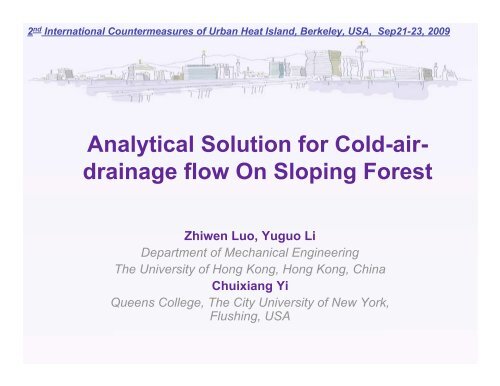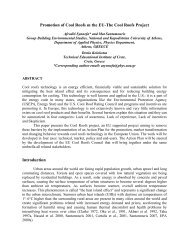Analytical Solution of Cold-air-drainage Flow Within and Above ...
Analytical Solution of Cold-air-drainage Flow Within and Above ...
Analytical Solution of Cold-air-drainage Flow Within and Above ...
You also want an ePaper? Increase the reach of your titles
YUMPU automatically turns print PDFs into web optimized ePapers that Google loves.
2 nd International Countermeasures <strong>of</strong> Urban Heat Isl<strong>and</strong>, Berkeley, USA, Sep21-23, 2009<br />
<strong>Analytical</strong> <strong>Solution</strong> for <strong>Cold</strong>-<strong>air</strong><strong>drainage</strong><br />
flow On Sloping Forest<br />
Zhiwen Luo, Yuguo Li<br />
Department <strong>of</strong> Mechanical Engineering<br />
The University <strong>of</strong> Hong Kong, Hong Kong, China<br />
Chuixiang Yi<br />
Queens College, The City University <strong>of</strong> New York,<br />
Flushing, USA
<strong>Cold</strong>-<strong>air</strong>-<strong>drainage</strong> <strong>Flow</strong><br />
Source: C.David Whiteman “Mountain Meterology”
<strong>Cold</strong>-<strong>air</strong>-<strong>drainage</strong> <strong>Flow</strong><br />
• Mitigate the nocturnal UHI<br />
– Kitada, 1998; Ohashi <strong>and</strong> Kida, 2002<br />
• Disperse the urban pollution<br />
– Baumbach <strong>and</strong> Vogt, 1999; Egan, 1984; Lu <strong>and</strong> Turco, 1994<br />
• Influence the nocturnal ecosystematmosphere<br />
exchange<br />
– Lee <strong>and</strong> Hu, 2002; Turnipseed et al, 2003; Yi et al, 2000
Hong Kong Isl<strong>and</strong><br />
Source: www.gearthblog.com
Physical model
19:00 pm<br />
Mar 15,2008
Ra=10 9 Ra=10 8<br />
Ra=10 7<br />
Ra=106
<strong>Analytical</strong> Models<br />
• Pr<strong>and</strong>tl model<br />
– One dimensional, but gives the detailed structure <strong>of</strong><br />
the flow pr<strong>of</strong>ile<br />
• Hydraulic model<br />
– Only provide the layer-averaged characteristic scales<br />
<strong>of</strong> flow parameters, i.e., velocity, momentum<br />
thickness, buoyancy deficit
Vegetation on Slope <strong>Flow</strong><br />
• Few studies address this problem<br />
– Bergen, 1969; Devito <strong>and</strong> Miller, 1983<br />
• Katabatic flow can occur both within <strong>and</strong><br />
above the tree canopies<br />
– Komatsu et al, 2003; Devito <strong>and</strong> miller, 1983; Pypker, 2007<br />
• Underst<strong>and</strong> the flow structure can help to<br />
estimate the surface fluxes
<strong>Cold</strong>-<strong>air</strong>-<strong>drainage</strong> winds---Forest Canopy<br />
katabatic wind above the canopy<br />
katabatic wind in the canopy<br />
Modified from Pr<strong>of</strong> Tree’s PPT
Aims<br />
Propose a simple analytical model<br />
by coupling both above <strong>and</strong> within<br />
tree canopies
<strong>Cold</strong>-<strong>air</strong>-<strong>drainage</strong> <strong>Flow</strong> Model<br />
z<br />
n<br />
h<br />
0<br />
x<br />
z<br />
s<br />
T<br />
Assumptions:<br />
_<br />
• One dimensional normal to<br />
the slope<br />
• Constant deficit <strong>of</strong> potential<br />
temperature in the canopy<br />
• Non-linear advection term is<br />
ignored in the momentum<br />
equation<br />
c D --- drag coefficient;<br />
a ---- leaf area density;<br />
LAI—leaf area index;<br />
"! --- deficit <strong>of</strong> the potential<br />
temperature ;<br />
h ---- canopy height
<strong>Flow</strong> <strong>Within</strong> Canopy<br />
(non-uniform)<br />
Momentum equation<br />
" u#<br />
w#<br />
=<br />
" n<br />
g&<br />
!%<br />
sin$<br />
+ c<br />
D<br />
au 2 ( n)<br />
Parameterizing the Reynolds stress (Yi,<br />
2008):<br />
$ ( z) / # = " u!<br />
w!<br />
( z)<br />
= c<br />
D<br />
( z)<br />
u 2 ( z)<br />
U<br />
"<br />
0<br />
cD(0)<br />
2 $ [ LAI $ L(<br />
n)]<br />
g'<br />
#&<br />
sin%<br />
$ [ L(<br />
n"<br />
) $ L(<br />
n)]<br />
( n)<br />
= $ ( U (0) e $ ! e dn"<br />
c<br />
( 2<br />
D(<br />
n)<br />
a(<br />
n)<br />
u<br />
D<br />
2<br />
cD ( n)<br />
u ( n))<br />
= g%<br />
! $ sin#<br />
+ c<br />
" n<br />
( n)<br />
c<br />
D<br />
( n)<br />
n<br />
( n)<br />
)<br />
1/ 2<br />
n<br />
L( n)<br />
= " a(<br />
n!<br />
) dn!<br />
LAI = L(0)<br />
# h
<strong>Flow</strong> <strong>Above</strong> Canopy<br />
Pr<strong>and</strong>tl Model<br />
!<br />
!<br />
"<br />
!<br />
!<br />
#<br />
$<br />
%<br />
=<br />
=<br />
%<br />
2<br />
2<br />
2<br />
2<br />
)sin<br />
(<br />
)<br />
(<br />
sin<br />
dn<br />
d<br />
k<br />
n<br />
u<br />
dn<br />
n<br />
u<br />
d<br />
k<br />
g<br />
h<br />
m<br />
&<br />
'<br />
(<br />
'<br />
&<br />
)<br />
)]<br />
/<br />
'cos(<br />
)<br />
/<br />
sin(<br />
[<br />
)<br />
(<br />
/<br />
l<br />
n<br />
C<br />
l<br />
n<br />
Ke<br />
n<br />
u<br />
s<br />
l<br />
n<br />
!<br />
"<br />
=<br />
!<br />
#<br />
4<br />
1<br />
2<br />
2 )<br />
sin<br />
4<br />
(<br />
!<br />
N<br />
k<br />
k<br />
l<br />
h<br />
m<br />
=<br />
m<br />
h<br />
k<br />
k<br />
N<br />
g<br />
K<br />
!<br />
=<br />
Pr<strong>and</strong>tl<br />
Pr<strong>and</strong>tl in 1905<br />
in 1905
Coupling at Canopy Top<br />
canopy<br />
above<br />
canopy<br />
in<br />
u<br />
u !<br />
! = )<br />
(0<br />
(0)<br />
s<br />
canopy<br />
above<br />
n<br />
canopy<br />
in<br />
n !<br />
!<br />
! "<br />
=<br />
= "<br />
" #<br />
=<br />
#<br />
= ,<br />
0<br />
0,<br />
canopy<br />
above<br />
n<br />
canopy<br />
in<br />
n<br />
dn<br />
du<br />
dn<br />
du<br />
!<br />
=<br />
!<br />
=<br />
=<br />
0,<br />
0,<br />
!<br />
"<br />
!<br />
#<br />
$<br />
%<br />
&&&&&&&&&&&&&&&&&&&&&&&&&&&&&&&&&&&&&&&&&&&&&&&&<br />
'<br />
(<br />
=<br />
)<br />
)<br />
'<br />
&&&&&&&&&&&&&&&<br />
*<br />
(<br />
'<br />
= '<br />
'<br />
*<br />
'<br />
'<br />
'<br />
'<br />
+<br />
0<br />
)]<br />
/<br />
cos(<br />
)<br />
/<br />
sin(<br />
[<br />
)<br />
(<br />
0<br />
)<br />
)<br />
(<br />
sin<br />
)<br />
(<br />
(0)<br />
(<br />
)<br />
(<br />
/<br />
2<br />
1/<br />
0<br />
)]<br />
(<br />
)<br />
(<br />
[<br />
)]<br />
(<br />
[<br />
2<br />
2<br />
n<br />
l<br />
n<br />
C<br />
l<br />
n<br />
Ke<br />
n<br />
U<br />
n<br />
h<br />
dn<br />
e<br />
n<br />
c<br />
g<br />
e<br />
C<br />
K<br />
n<br />
c<br />
c<br />
n<br />
U<br />
s<br />
l<br />
n<br />
n<br />
n<br />
L<br />
n<br />
L<br />
D<br />
s<br />
n<br />
L<br />
LAI<br />
D<br />
D<br />
,<br />
-<br />
,<br />
.
Validation <strong>and</strong> Discussion<br />
Leaf area density
Velocity Pr<strong>of</strong>ile<br />
Low-level jet<br />
Ri<br />
g ! T<br />
= T ! z " #<br />
2<br />
$ ! u %<br />
& '<br />
( ! z )<br />
Minimum vertical exchange<br />
Super-stable layer<br />
Minimum velocity <strong>and</strong> largest leaf area density
Sensitive Study<br />
---Uniform Case<br />
• Atmospheric Stability<br />
• Slope angle<br />
• Canopy morphology
Influence <strong>of</strong> Atmospheric Stability <strong>and</strong> Slope Angle<br />
400<br />
350<br />
300<br />
!=5°, "=2 K/km<br />
!=5°, "=4 K/km<br />
!=10°, "=2 K/km<br />
Steeper slope<br />
)<br />
m<br />
(<br />
H<br />
250<br />
200<br />
150<br />
Weak stability<br />
100<br />
50<br />
Strong stability<br />
Canopy top<br />
0<br />
-3.5 -3 -2.5 -2 -1.5 -1 -0.5 0<br />
Velocity (m/s)
)<br />
m<br />
(<br />
Influence <strong>of</strong> Plant Canopy<br />
y<br />
p<br />
o<br />
n<br />
a<br />
c<br />
220<br />
200<br />
180<br />
LAI=2<br />
LAI=4<br />
LAI=10<br />
e<br />
h<br />
t<br />
e<br />
v<br />
o<br />
b<br />
a<br />
160<br />
140<br />
120<br />
100<br />
80<br />
LAI=4<br />
LAI=2<br />
t<br />
h<br />
g<br />
i<br />
e<br />
H<br />
60<br />
40<br />
20<br />
LAI=10<br />
0<br />
Canopy Top<br />
-20<br />
-6 -5.5 -5 -4.5 -4 -3.5 -3 -2.5 -2 -1.5 -1 -0.5 0<br />
Velocity (m/s)
Conclusions<br />
• <strong>Analytical</strong> solution on cold-<strong>air</strong>-<strong>drainage</strong> winds by<br />
accounting for the influence <strong>of</strong> tree canopy is<br />
obtained.<br />
• The effect <strong>of</strong> atmospheric stability <strong>and</strong> slope<br />
inclination is also investigated.<br />
• The influence <strong>of</strong> different leaf area indexes is<br />
studied.
Thank you!






